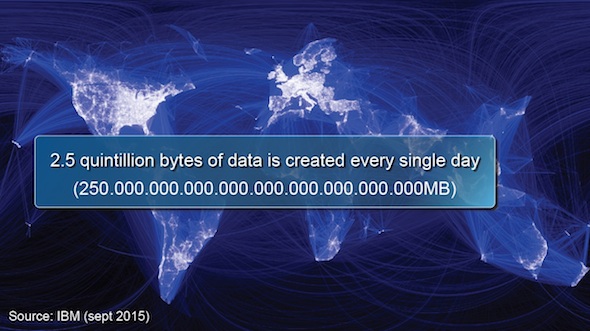
On the occasion of the October ‘FastTrack Days’ in Paris, Andy Zondervan of the New Business Development Department at Buma / Stemra, showed the participants the many possibilities that are rising in the world of “Big Data” through his presentation on “Music Industry Data Trends in a Connected Multimedia World”. Let’s summarize the essence of Andy’s presentation here.
The size of the digital world is beyond our imagination: 2.5 quintillion bytes of data is created every single day (which is equal to a stunning number of 250.000.000.000 000.000.000.000.000.000MB), and the amount of creative content is rising each year with 1800%! In a world where 5,8 billion persons (data from 2014) have access to the Internet, where everybody can become a creator.
At the same time the data storage is getting much bigger, cheaper and more accessible in a very short period of time. The use of data can change processes we have known for centuries, and the same applies for the processes in the Music Industry where innovation is the key: in this context it’s important for FastTrack and its associated organizations to change the way of thinking the use of data. MusicMetric, an analytic music company recently bought by Apple, says that they are able to predict with 90% accuracy which song will be a number one hit three months in the future, just by using the right algorithms.
Isn’t it time for the Collective Management Organizations (CMOs) to start using data not only for collecting revenues, but also to help generate a lot more profit for the Music Industry? By focussing on the end-user instead of solely on the artist himself. By focussing on the needs and wishes of the end-user (by looking at Big Data), the Fast Track solutions could give CMO’s more cooperation with other music companies who collect big data. This cooperation gives the use of data by CMO’s more relevance and in the long-run, and in the end more profit for the music creators, authors and publishers.
It is time to use the unique data the CMO’s have, like the ‘live market data’, which is retrieved by the collecting of all the setlist data. This would allow the authors and publishers attached to the CMO’s to benefit from some necessary innovations, like predicting the commercial success of certain artists. Because the reality of today – and the risk for CMOs - is that other commercial companies will start to make money of the same data, which will not benefit the members of the CMOs, but only the commercial companies that will use the data.
Max Nederkoorn, Public Affairs Buma / Stemra
Based on a presentation of Andy Zondervan
« Back to Home